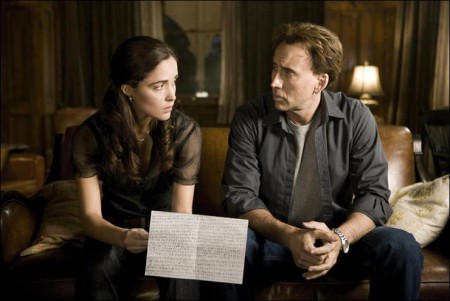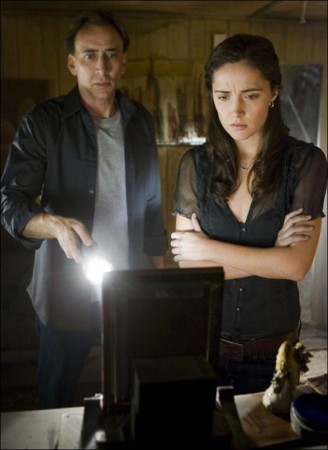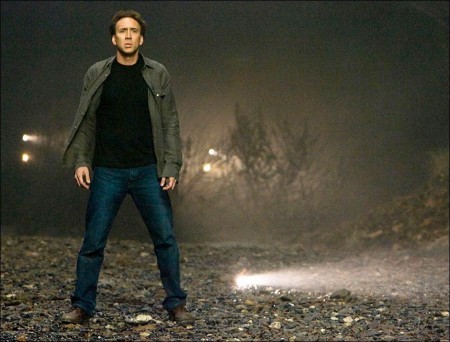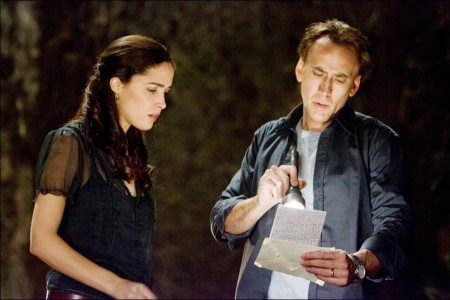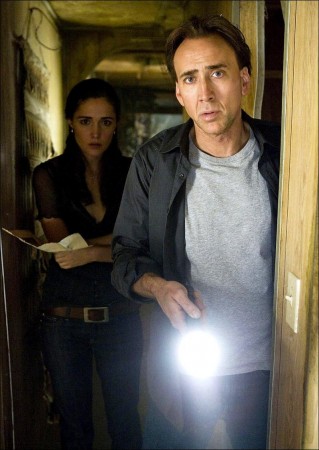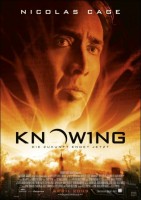About the Production
A single father desperately trying to defend his only child and a half-century old encoded message written by a young schoolgirl may be all that stand in the way of impending global disaster in the captivating sci-fi thriller Knowing. From the moment they heard Ryne Douglas Pearson’s (Mercury Rising) idea for the screenplay, producing partners Jason Blumenthal and Todd Black knew they had an unforgettable story to tell.
“We spent eight years developing the script,” recalls Blumenthal. “We bought it as an original pitch. Ryne had an idea that started with a time capsule that was buried in the 1950s and unearthed in the present day. The capsule contains a series of predictions that would come true. We knew immediately we had something very special.”
For the last five years, the partners have been working with Alex Proyas, the acclaimed director of I, Robot, to develop the idea into a feature film. “With a pitch, you never know how the final screenplay is going to turn out,” says Blumenthal. “The story has changed in small places, but the larger overall themes have always remained the same. The idea of the time capsule and the predictions was such an intriguing and unique idea that we knew we had something to build on. It’s as exciting to us today as it was eight years ago. And seeing it come to life is amazing.”
Proyas was chosen to direct Knowing based on the singular filmmaking style he has honed since his 1994 breakthrough film, The Crow. “We knew we found the right director in Alex,” says Blumenthal. “His vision for this picture far surpassed anything that we could ever realize on the page. He brought in a whole host of scientific, spiritual and philosophical ideas that helped bring the script together.”
For Blumenthal, real-life events of the past eight years have caused a shift in what he sees as the most compelling aspects of the film. Initially he was intrigued by the concept of the time capsule: “I remember hearing about them as a kid. It sounded so sci-fi and out there, and when I realized that it was something that was going to be opened many years from that date, I was hooked. When I.m looking at ideas I want to develop, I look for things that have an emotional connection for me, and that one did it for me.”
Then during the development period, Blumenthal’s life changed dramatically. “Eight years ago I was not a father. I have two young children now. And at its core, the movie has become a parent and child story. That central family issue is very important to me and many other people on this film.
“Knowing is an edge-of-the-seat psychological thriller with special effects that are going to blow your mind,” he says. “But it.s more than that. This movie poses the ultimate question: How far would you go to protect your child? Would you be willing to make the ultimate sacrifice?
“It’s an emotional rollercoaster that leaves you guessing at every turn. It.s a story that people will want to talk about because it poses many questions that will stay with them when they leave the theater. And for me, those are the best stories to tell.”
For Proyas, that meant finding a balance between the over-the-top action and visual effects of a top-flight thriller and the nuanced emotional journey of his characters. “For me, every film is a big film,” he says. “I, Robot was a hugely complex technical exercise, but every film has its own levels of complexity. The great thing about Knowing is that is it has this bedrock of emotions and human interaction. Reality is what this story is all about what. We don.t ask you to suspend disbelief. Everything that we.ve addressed in this could possibly happen.”
Actor Nicolas Cage, who plays Professor John Koestler, compares the script to an enduring American icon. “The script reminded me of one of Rod Serling’s “Twilight Zone” teleplays, and the powerful feeling that those shows had,” he says. “It.s a science fiction-mystery-thriller, but there are also some intensely dramatic moments.”
Rose Byrne, the actress who plays Diana, agrees that it is hard to place Knowing in a single genre, a quality she sees as one of the film.s strengths. “The storyline unfolds really cleverly and the time capsule is fascinating. This is not just a straight thriller or a straight horror or a straight science fiction film. It.s a dead-even combination of those things.”
“It’s a movie that has the ability to change people.s minds,” says Cage. “I remember seeing The China Syndrome as a boy and it made me very aware that nuclear energy was a power to be respected. This calls people.s attention to issues that we can all affect in some way.
“The end of the world is on people’s minds,” he goes on. “We have the power to do it ourselves. The question is, what do you do with that responsibility?”
Movies with apocalyptic themes are particularly resonant with audiences because of the environmental issues the world is dealing with, says Byrne. “It’s a constant human desire to want to understand as much as we can about how long we’re going to be around,” she says. “People have been trying to figure it out forever. And whether it’s Mayans or Muslims or Hindus, everyone has a theory on what’s going to happen.”
The filmmakers hope that Knowing will be the kind of film that starts conversations that continue long after audiences have left the theater. “People go to movies to see something big, something fun, something kind of special that they haven.t seen before,” says Blumenthal. “And we think we.re giving them that.
“I believe audiences want to be challenged to come to their own conclusions,” he adds. “This movie has a definitive ending, but it leaves a lot open for debate. A movie that ends when the credits roll is not as important to me as one that keeps you talking when you get in the car. I want people to talk about this movie, and ask themselves, „Would I have done that?. This is a story that I believe people are going to want to talk about. And that.s the kind of movie that I want to make.”
About the Casting
With their ideal director lined up, a finished script in hand and a studio ready to finance the project, the filmmakers set out in search of their lead actor. “At that point, the most important part became finding our hero,” says Blumenthal. “Who.s the guy who will carry us through?”
Academy Award winner and international superstar Nicolas Cage brings the air of an event to every project he tackles. His commitment and dedication have made him one of the most soughtafter actors in the world. “We always knew that Nic Cage was the perfect person to play this part,” says Blumenthal. “Nic brings an intensity, but at the same time an accessibility, to this character that most actors couldn.t deliver. I also think Nic believes in many of the themes we address in this movie.
“I also believe there.s something about the role and the story that speaks to him emotionally because he.s the father of a young son,” continues Blumenthal. “He has understanding of what a father would have to go through and the kind of decisions a father would have to make in this situation.
“Plus, he.s an amazing person, he’s an amazing actor and he brings real humanity to every role he takes on,” adds Blumenthal, who produced The Weather Man, which also starred Cage. “It was also perfect because Nic was a fan of Alex.s and Alex was a giant fan of Nic.s. Sometimes the planets align properly and everything seems to come together. That.s what happened on this film.”
Cage and Proyas both jumped at the chance to collaborate on the project. “I had wanted to work with Nicolas for a long time,” says the director. “It is always exciting to finally get to work with someone you.ve always wanted to work with.”
For Cage, the combination of the unique and provocative script and Proyas in the director.s chair made Knowing an irresistible opportunity. “It can be a challenge to find original stories and outlooks. Alex is an original, an artist with a point of view.”
The Oscar-winning actor found the role of John Koestler particularly satisfying from an emotional standpoint. “He.s remarkably devoted to his son and he has the added pressure of raising him alone. We don.t see the concern that fathers have for their children often enough in movies. That.s another one of the reasons I wanted to do this film.
“John’s only priority is keeping his son safe,” says Cage. “There’s a very emotional moment in the movie when Caleb asks, „Am I gonna die now?. And my character says, „That will not happen. I will not let that happen to you.. He will stop at nothing to fulfill that promise. At that point, the film becomes largely about what John can do to keep his promise.”
Australian actress Rose Byrne.s career has included big-budget blockbusters such as Troy as well as acclaimed small-scale projects such as I Capture the Castle. She was recently nominated for a Golden Globe for her role opposite Glenn Close in the award-winning television series “Damages.”
“Rose and I had wanted to work together for a while,” says Proyas. “She brings such depth to everything she does on screen. That.s especially important in this film because much of what people are thinking and feeling is not always expressed with words.”
Long an admirer of Proyas. work, Byrne says the chance to work with the director was “a huge draw.” “I.ve really enjoyed working with Alex. He knows exactly what he wants, and he’s very compassionate towards his actors. He.s very much about the story and the characters.”
“Also, the fact that it.s a very intimate story between these four characters in this larger-than-life situation makes it very attractive to me as a performer,” says the actress. “My character, Diana, is in such a complicated position. She has a really dark personal history and it all comes crashing down on her. She tried to run away from this thing her whole life and it ends up right in her face. It was quite a challenging part. It’s a big responsibility to make it as real and as powerful as possible.”
Rose Byrne was selected after an audition process that spanned several continents. “There was just something about Rose,” says Blumenthal. “She has a freshness. From day one, Alex was sure she was the right choice. As he says, she has a real humanity. You can feel the pain and emotion that she’s going through as she is discovering that these predictions that have set this story in motion started with her mother years ago.”
Working with Cage, Byrne says, always carried the promise of the unexpected. “It was a blast. Nic is incredibly passionate about what he.s doing. You don.t really know what to expect. He really threw a curveball at me in our first scene. We rehearsed it and discussed it, and then he came at it another way, which was really thrilling to figure out. It turned the scene from being quite gentle and subtle into something that was really his character losing it a little bit. It’s exciting to work with Nic because his mind is always one step ahead.”
For his part, Cage was impressed by his leading lady.s onscreen authenticity. “Rose is tremendously real,” says the actor. “She has the emotions required to make the situations in the film so palpable that people in the audience have to go with it. Rose has that ability to draw it as though it’s actually happening.”
Two very young actors, Chandler Canterbury and Lara Robinson, shouldered critical roles in Knowing. The filmmakers went on a major talent hunt for the young actor who would play Caleb Koestler. Chandler Canterbury was nine years old when he shot Knowing. He had already won a Young Artist Award for his appearance on the television drama “Criminal Minds” and worked with Brad Pitt and Cate Blanchett in The Curious Case of Benjamin Button and Jude Law and Forest Whitaker in Repossession Mambo. “I did my first audition on video and my mom sent it on the Internet like every other audition that I have done,” he says. “Then they asked me to read the whole script so I could learn more about my character. Caleb is very sad because his mom is dead. He can’t see eye-to-eye with his dad, but he really loves him.”
The challenge, says producer Blumenthal, was finding a child actor who didn.t come off on screen like a child actor. “He had to be real. There was just something special about Chandler. It was something that we hadn.t seen before. It.s not that precociousness that you get with a lot of kid actors in Hollywood. Chandler lives in Texas and there’s something about not growing up in Hollywood that translates to who he is as an actor.”
Ten-year-old Lara Robinson took on two challenging roles in Knowing. She plays both Lucinda, the little girl who starts everything, as well as Abby, who is Lucinda.s granddaughter and one of the keys to the mystery. “I liked playing two characters in the movie,” the Aussie youngster says. “They were totally different. Lucinda was fun because she.s scary and sad and weird. And Abby’s fun because she.s normal.”
About her costar, she says, “I would describe Chandler as a good actor. But he.s definitely a boy. He would ask me things like, would I shave my head for a movie? Or would I want to take my eyebrows off for a movie? Would I want to get rid of an eye for a movie? And I would say no to all those questions.”
“Lara and Chandler both were amazing in the way they understood what it takes to make a movie,” says Blumenthal. “They.re great because they.re real kids. The minute we yell cut, they’re back to just being kids. They.re playing and having a good time and they enjoy it. And there’s something so exciting about watching these kids enjoy what they do.”
Making Knowing – Step By Step
The Australian city of Melbourne, which stands in for the Koestlers. hometown of Boston, provided the Knowing filmmakers with first-rate production professionals and facilities.
“It was my first time working in Australia, and the crew was excellent,” says Blumenthal. “Top to bottom, the technical know-how was equal to anywhere we.ve ever shot a movie. And these are people who have worked together before, so they have a shorthand. There.s a lot of moving parts on a film set and if they aren.t synchronized it can cause problems.”
For Proyas, who has worked often in Sydney, Melbourne was a treat. “It was exciting to be somewhere where I could see some new stuff and work in some new places,” he says. “It’s actually a bit easier to work here than Sydney where.s there.s so much traffic and everything gets a little crazy. It’s a very amenable city for filmmaking right now.”
Production designer Steven Jones-Evans was charged with the task of transforming Melbourne into Boston. “Melbourne has been in a drought for the last five years, so the grass was totally brown,” he remembers. “It was very hard finding anything when we needed gardens or anything like that. We used Melbourne University for MIT, and the lawn there was totally parched, so the week before, we went there and sprayed the whole lawn green.
“Luckily, a lot of the film was set in autumn and the shoot coincided with that season in Melbourne. It.s not the autumn that you get around the Boston area, which is a lot more colorful, so we were constantly lugging around these huge bags of colored leaves that we.d spread out everywhere.”
For the Koestler home, Jones-Evans wanted an archetypal New England house. “The idea was that he and his wife bought it in a slightly dilapidated state, planning to bring up a family in it, to renovate it, and return it to its former glory. There were a lot of personal things that we built into the house, like Caleb.s room. We decided to make it an attic room with one circular window right in the front, which is a motif that Alex has used often.”
The production designer also included lots of items related to nature, like toy animals or images of landscapes. “The idea was that Caleb was interested in things that connected him to the Earth.”
Jones-Evans also was responsible for creating the item at the center of the film.s mystery: the time capsule. The idea goes back to the 1939 World.s Fair, whose organizers hit upon the idea of burying a sort of message in a bottle for future generations. The metal container, which was buried on the fairgrounds as part of the Westinghouse Company.s exhibit, contained such staples of contemporary life as a needle and a spool of thread, a newsreel and microfilm copies of both a dictionary and the latest Sears Roebuck catalog. It was meant to be unearthed in the year 6939.
“We looked at other time capsules,” says Jones-Evans. “There were so many different designs. The Westinghouse capsule was a missile-shaped thing, which we decided was too militaristic for our use.”
The designer went back to 1958 for his inspiration. “The design is informed by that era, but it is not a pure vintage thing. It.s a little more classically shaped and made of stainless steel. It has a lid on it that screws down with two wing nuts. We kept it simple because it was more about what was going inside the capsule, rather than the capsule itself.”
Working in 1950s design vernacular for the first part of the film was a pleasure for the designer. “It was an interesting time. There was a lot more hope and a lot less cynicism in the world. Pollution and other environmental problems were only just becoming issues. So it was a much more pure, hopeful age. We went for a slightly brighter color palette in those scenes to make that feel a little bit more cheerful and hopeful.”
One of the film.s most challenging sequences, the airplane crash, required both Jones-Evans. design skill and some help from the visual effects team. “Alex wanted to do it as a single shot. He wanted to bring the plane in, fly it through a telephone pole and hit a car with its wing. The car flips up and it crashes into a field and breaks into pieces. We built the actual wreckage of the plane, but it wouldn.t have been possible to get everything in one shot without a lot of help from the effects department.
“I enjoy working with visual effects in order to complete or augment something we.ve done,” he adds. “The visual effects supervisor was on from the early stages of preproduction, so there’s been quite a bit of information and dialogue and chatting about how to solve certain sequences or problems that we have.”
Knowing is one the first feature films to be shot with the Red One Camera, the latest in lightweight high resolution digital technology. Simon Duggan, the film.s director of photography, says the Red One Camera has filmmakers looking at digital cameras in a new light.
“The skin tones are soft and look fantastic. There.s hardly any noise or grain in the images. We were looking for a very immediate quality for our picture and this is virtually identical to film.”
Proyas and Duggan conducted extensive tests before deciding to go with the digital format. “They were both excited about the potential of using the camera,” says Blumenthal. “It made things move very quickly. We were able to do so much more on set than when we used to have to wait to do it in post, like tweaking color.”
“Alex hates for anything to look lit,” notes Duggan. “With the Red One Camera, we didn.t have to wait overnight just to see if a lighting scheme worked out. It.s all immediate, and we ended up having more confidence in pushing the limits of what we were doing.”
As a producer, Blumenthal had to balance the excitement of being a digital pioneer and the anxiety of feeling like a digital guinea pig, he says. “But we try to be as forward thinking as possible, and this was a real learning experience. This technique provided us with an opportunity to present our story with a unique new look. With the way technology is advancing, what used to be science fiction is now science fact, and we used it because it could give us the best qualityproduct.”
What Would You Put in a Time Capsule?
Like most people, the cast and crew of Knowing have never had the opportunity to put anything in a time capsule, but all of them had unique suggestions.
Lara Robinson: Well, I.ve never seen a time capsule, but I have heard about them. I.d put in my favorite songs. I.d probably put in some classical music and some jazz things and some sort of modern music. I would put in photos of what our computers and electronic things look like to see if they.ve changed. I would put a journal of a year of my life and photos of landmarks in Australia. And I.d put a globe in, just in case things change. Finally, I would put in a book about Australia. I.d probably put a time capsule in for a hundred years and see what the difference is then.
Rose Byrne: I.d like to put in a diary, something a bit racy, with good secrets, so it would be entertaining for the person who found it.
Chandler Canterbury: I would put in a picture of my family to show what fun we’ve had together…and maybe Legos.
Steven Jones-Evans: I.d like to put myself into a time capsule. That would be the greatest thing, if I could preserve myself and put myself into a time capsule and come out and see what the future is going to be like. Maybe just my brain or something like that.
Nicolas Cage: It would be interesting to put this movie into a time capsule, because then it would become very cubist.
Production notes provided by Summit Entertainment.
Knowing
Starring: Nicolas Cage, Rose Byrne, Chandler Canterbury, Lara Robinson, Nadia Townsend, Adrienne Pickering
Directed by: Alex Proyas
Screenplay by: Alex Proyas, Stuart Hazeldine, Juliet Snowden
Release Date: March 20, 2009
MPAA Rating: PG-13 for disaster sequences, disturbing images and brief strong language.
Studio: Summit Entertainment
Box Office Totals
Domestic: $79,957,634 (45.4%)
Foreign: $96,217,509 (54.6%)
Total: $176,175,143 (Worldwide)

